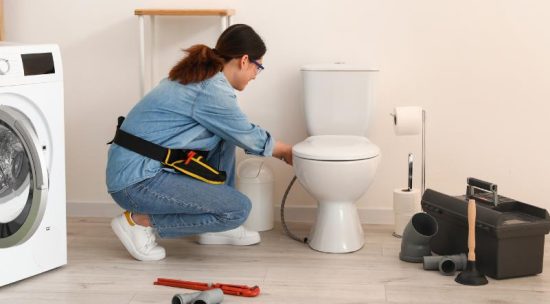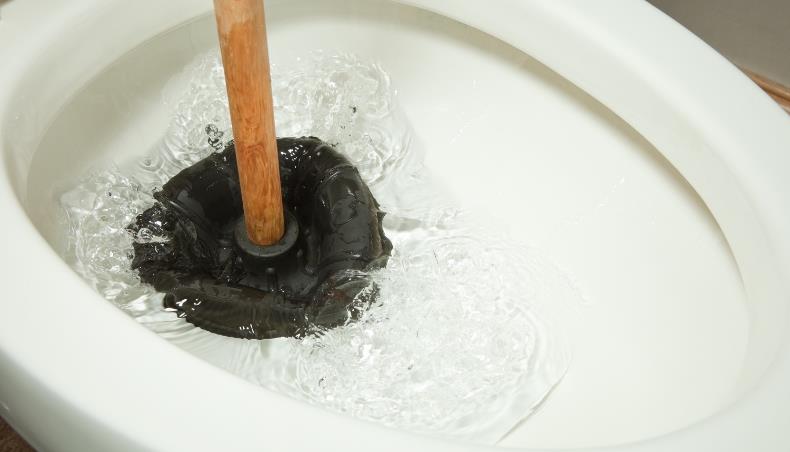Having to deal with a blocked toilet is a typical yet upsetting household problem, mainly when it is filled with water and poop. This is an annoyance that has to be fixed right away to avoid overflow and other issues. By knowing how to unclog a toilet full of poop and water can save you time and potential embarrassment. Thankfully, there are a few simple ways to deal with this, so your bathroom may be restored to working condition quickly. Your daily routine can return to normal, and stress levels can be lowered by learning to complete this unpleasant activity swiftly and effectively. You may prevent this issue from worsening and maintain a clean and comfortable house by taking the appropriate action.
How to Unclog a Toilet Full of Poop and Water?
1. The Plunger Method
Plungers are a common household item, and you should always try them first when dealing with clogged toilets. Seal tightly around the bowl’s bottom hole to get the best results. Once the seal is in place, create enough suction by diving firmly and steadily. This process helps in removing the obstruction from the pipe. A little muscle and multiple tries may be needed, but constant plunging usually clears primary obstructions. Take one last go when you sense the pressure changing, and then flush to see if the water flows freely. Give yourself a minute to pass and try plunging again with more power if the toilet is not clearing.
2. Hot Water and Dish Soap
If the plunger fails, your next option is hot water mixed with dish soap. The soap can acts as a lubricant to help break down the organic elements in the clog, and the hot water softens the obstruction, making it easier to remove. Pour some hot water and a tiny dish soap into the toilet bowl. To help the fluid penetrate and dissolve the blockage, let it sit for approximately 10 minutes. After allowing the soapy water to work, try diving again. This method can be surprisingly effective, mainly if the obstruction is caused by organic debris and toilet paper.
3. Baking Soda and Vinegar
Combining baking soda and vinegar is very effective for those who prefer a natural remedy. First, fill the toilet bowl with one cup of baking soda powder and two cups of vinegar. The liquid will bubble and fizz, a positive reaction for dislodging the clog. As the foaming activity penetrates the obstruction, give it a few minutes to continue. Check if the clog clears by flushing the toilet after letting it settle. This approach is eco-friendly and safe for your plumbing.
4. Toilet Auger
A plumbing snake, a toilet auger, may reach farther down the drain than a standard plunger. The auger’s cable should be inserted into the toilet bowl and extended until the blockage presents resistance. Turn the auger handle carefully to help break up or capture the obstruction. To remove any debris that may be the source of the obstruction, carefully retract the auger. This instrument is beneficial for hard-to-reach obstructions farther down the pipe that plungers cannot reach.
5. Wet/Dry Vacuum

When all other approaches fail, there is always the option of using a wet/dry vacuum. First, vacuum remove all the water from the toilet bowl. After emptying the toilet, firmly wrap a cloth over the vacuum hose to plug the drain. To try to suction out the obstruction, turn on the vacuum. You should only use this procedure if you are confident that your vacuum can withstand wet operations and take care not to damage it.
6. Eco-friendly Enzyme Cleaners
Enzyme cleaners are particularly effective on organic clogs composed of human waste. These cleaners use natural enzymes to destroy the waste material in the clog without harming the plumbing. Pour the recommended amount of enzyme cleaner and let it sit for 12 hours, allowing ample time for the enzymes to work on the clog. Flush the toilet in the morning to clear out the disintegrated material. This method is an excellent choice for maintaining clean pipes and is safe for regular use.
7. The Closet Hanger Method
If appropriate equipment is unavailable, a basic wire hanger can be used as a do-it-yourself option. Keep a tiny hook at one end of the hanger while you straighten it. To avoid scratching the porcelain, wrap this end with a towel. Gently push the hanger through the obstruction after carefully inserting it into the toilet bowl. To remove the obstruction or hook onto any obstacles, move it around. Pull the hanger out once you feel less resistance and flush the toilet to clear any loosened material. This method is a quick fix and can be surprisingly effective in emergencies.
When to Call a Professional?
No matter how many techniques you use, there are situations when a blockage refuses to go away. If none of the solutions listed above work, it could be necessary to hire a licensed plumber. Recurring blockages may be a sign of a more serious problem with your plumbing system that needs to be professionally fixed. If you keep trying to clear it yourself, you can end up with damaged pipes or a worse spill.

Plumbers with experience and the right equipment can identify and fix issues that are hard to reach or identify. They can also look for problems from repeated clogs, such as collapsed pipes or tree roots. When you flush, if water backs up in other parts of your house, it could indicate an issue with your main sewer line. In certain situations, an expert can only sufficiently resolve the problem. Ultimately, spending money on expert services might spare you from expensive repairs brought on by careless handling.
Preventive Measures while unclogging a toilet full of poop and water
Preventing toilet clogs is important for maintaining a smoothly running bathroom. Here are eight effective strategies to minimize the risk of blockages:
- Flush only human waste and toilet paper.
- Avoid flushing non-biodegradable items.
- Regularly clean your toilet.
- Occasionally use enzyme cleaners.
- Educate all household members on proper toilet use.
- Install modern toilet fixtures.
- Conduct regular plumbing inspections.
- Use thinner, septic-safe toilet paper.
Conclusion
Suppose you have the proper equipment and know-how; unclogging a toilet that is full of poop and water can be a manageable task. Recall that cautious usage and routine maintenance are the most robust protections against future jams. Using these techniques, you can maintain the hygienic and free-flowing condition of your toilet. Feel free to contact a professional to handle the issue safely and efficiently if troubles continue. Repeated difficulties could indicate more severe plumbing concerns, and resolving them quickly can save more serious consequences. You can maintain the efficiency of your system with routine maintenance and awareness of what flushes down the toilet. By following these guidelines, you can keep your bathroom functional and clean, improving your house’s general comfort and health.
FAQs on how to unclog a toilet full of poop and water
1. What should I do first if my toilet is clogged?
First, try using a plunger. Make sure to create a good seal over the toilet bowl’s exit hole and plunge vigorously to dislodge the blockage.
2. Can hot water help in unclogging a toilet?
Yes, hot water can help dissolve clogs, especially with dish soap. Pour not boiling hot water into the toilet bowl with dish soap, let it sit, and then try plunging again.
3. Are chemical drain cleaners safe for toilets?
It’s generally advised to avoid chemical drain cleaners for toilets because it can damage the porcelain and the plumbing. Choose natural options like baking soda and vinegar, or use a mechanical tool like a plunger or a toilet auger.
4. How do I use a toilet auger?
Insert the end of the auger into the toilet bowl, pushing it through the drain until you feel resistance. Crank the handle to remove the clog, then retract the auger. Then, flush the toilet to clear any remnants of the blockage.

